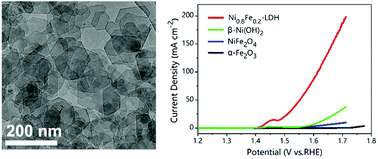Controllable structure reconstruction of nickel–iron compounds toward highly efficient oxygen evolution†
Abstract
Nickel–iron (Ni–Fe) compounds have received ever-increasing interest because of their high performance for the oxygen evolution reaction (OER). However, the structure and composition of the active phase of Ni–Fe compounds are not yet understood. Rational design of Ni–Fe compounds with proper composition and exposed active sites is highly desirable to further improve their performance. Here we reported the synthesis of different Ni–Fe compounds by incorporating Fe into the Ni(OH)2 lattice with controlled concentrations and obtained several products including Ni–Fe layered double hydroxides (LDHs) with different amounts of Fe and NiFe2O4. In addition, β-Ni(OH)2 without Fe and α-Fe2O3 without Ni have also been synthesized for comparison. Among these four Ni/Fe based compounds, we found that the two-dimensional (2D) Ni0.8Fe0.2-LDH nanosheets with a hexagonal shape manifest a highest OER activity with a lowest overpotential of 235 mV at 10 mA cm−2, a smallest Tafel slope of 41 mV dec−1 and excellent stability over 24 h. In situ Raman, X-ray absorption spectroscopy and X-ray photoelectron spectroscopy show that the enhanced activity of Ni0.8Fe0.2-LDH is due to the increased oxidation state of Ni from Ni2+ to Ni3+. Our findings demonstrate that the composition of Ni–Fe compounds influences the oxidizing ability of Ni and consequently their catalytic performance. We also reveal a strong correlation between the structure and oxidizing power of the Ni in Ni–Fe compounds and their OER activity, indicating that the well-engineered structure and Ni-site electronics are the primary origins of their OER activity. This work not only provides a promising guideline for the design and synthesis of Ni/Fe based compounds, but also highlights the crucial role of each component in enhancing the activity of these electrocatalysts.



 Please wait while we load your content...
Please wait while we load your content...